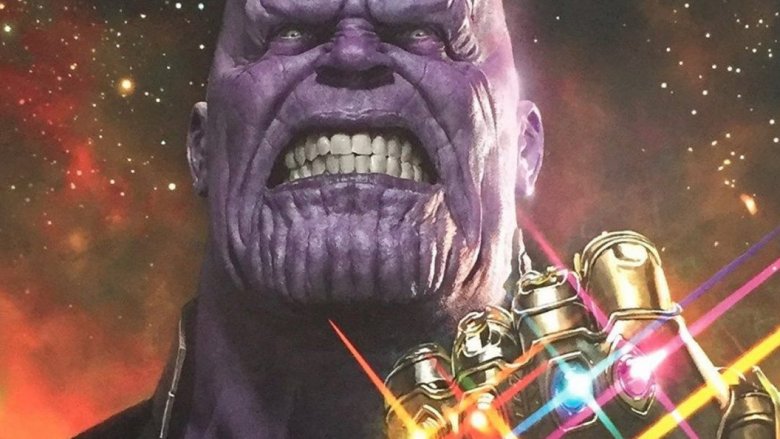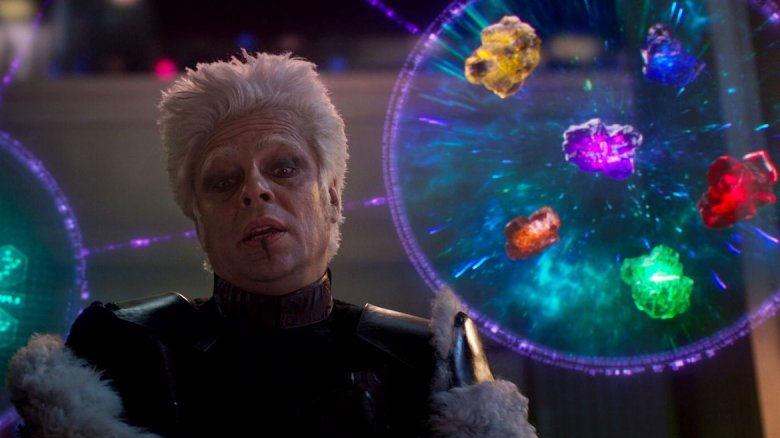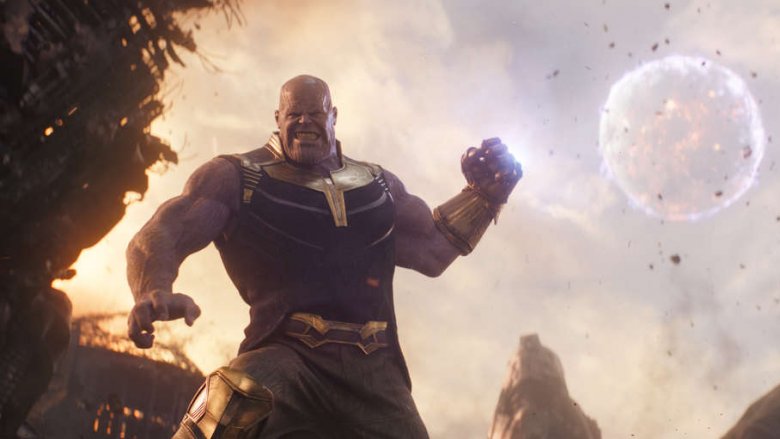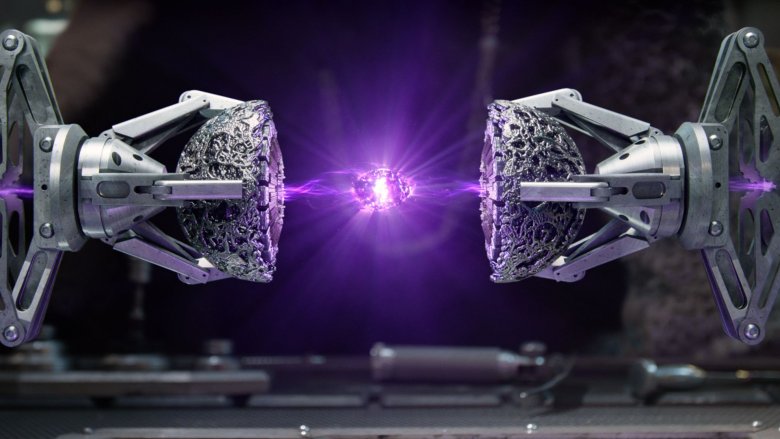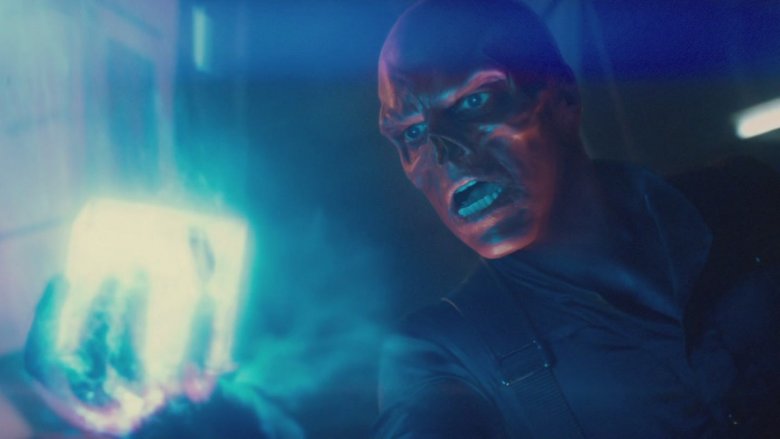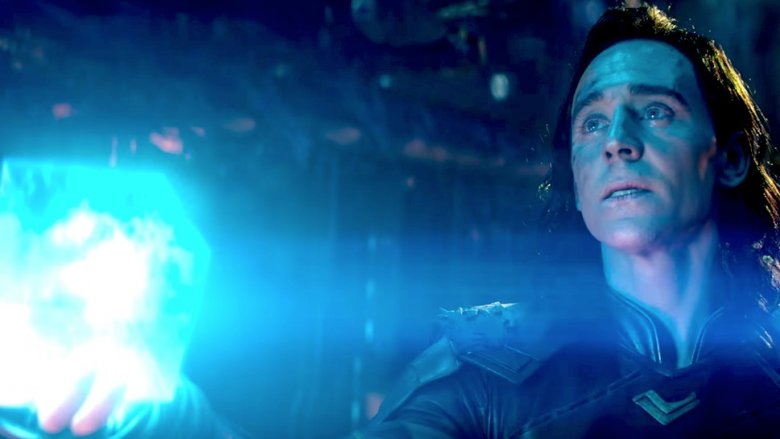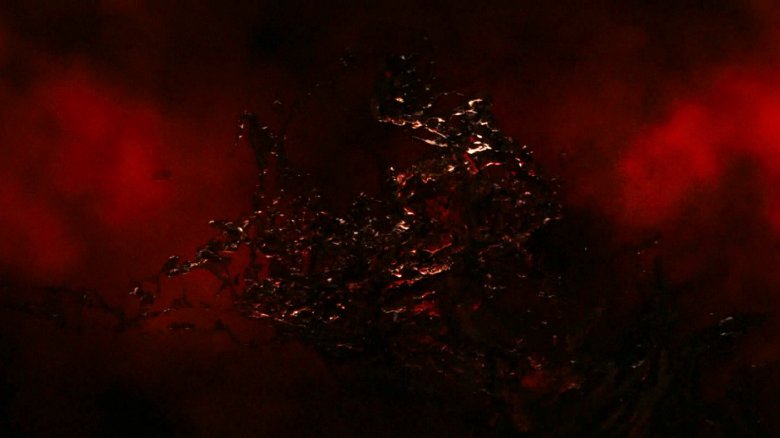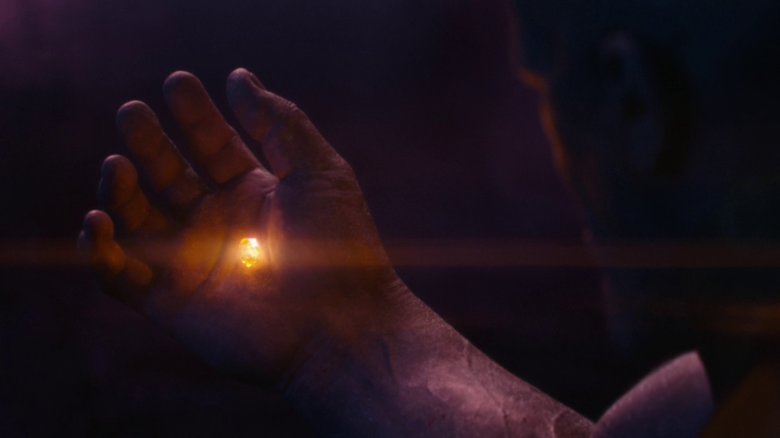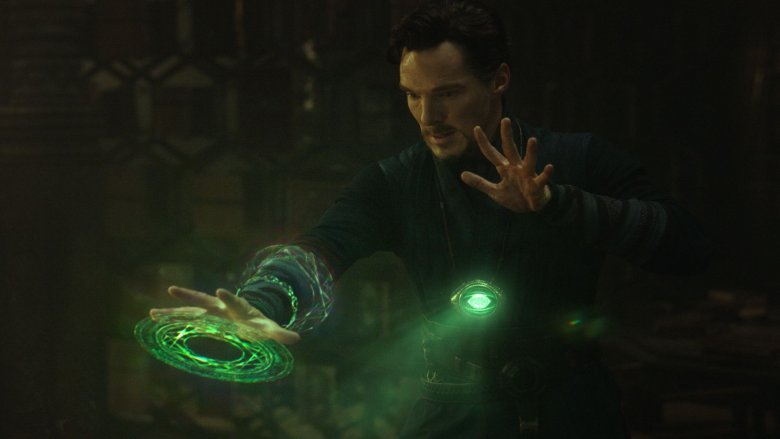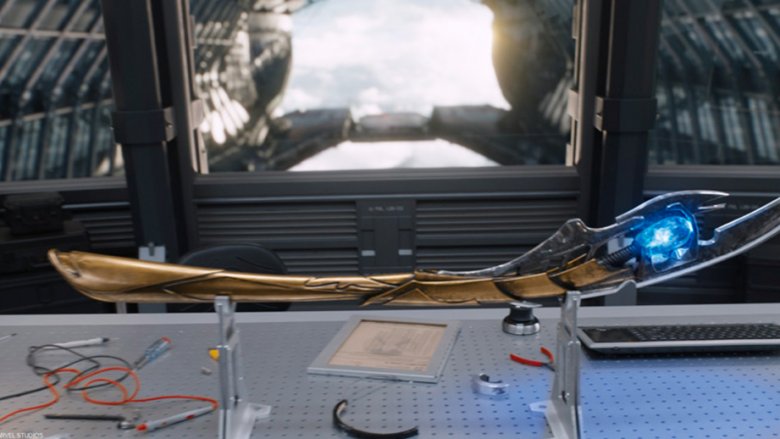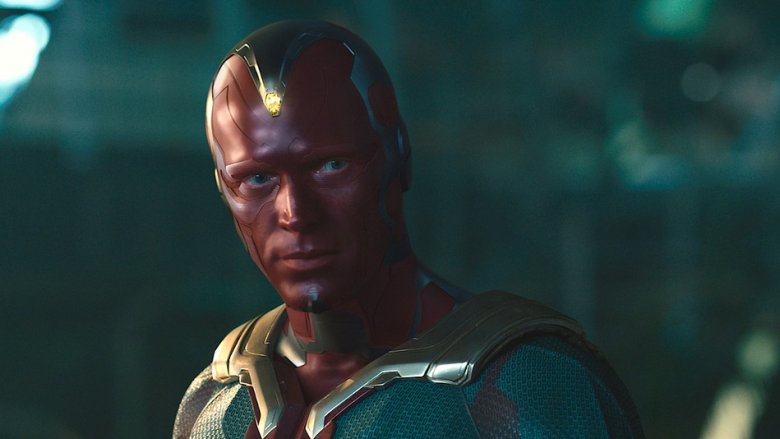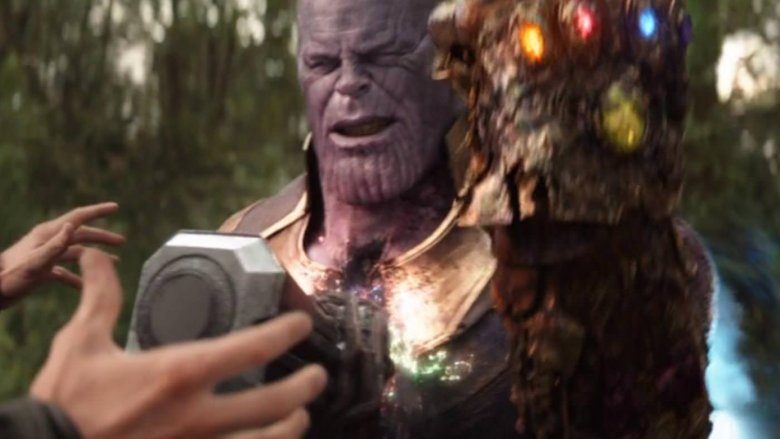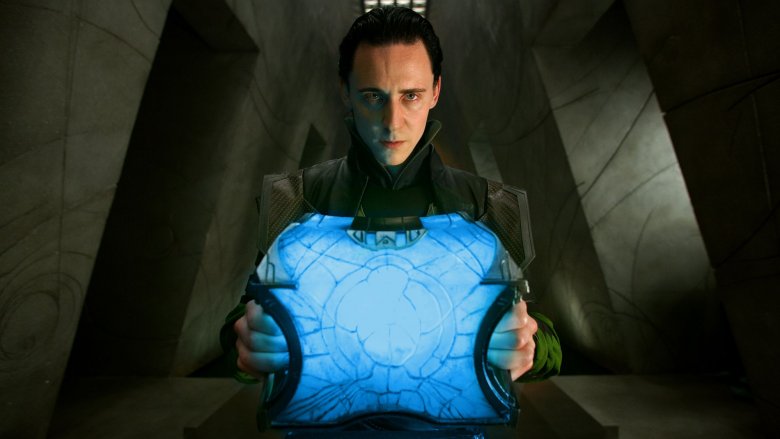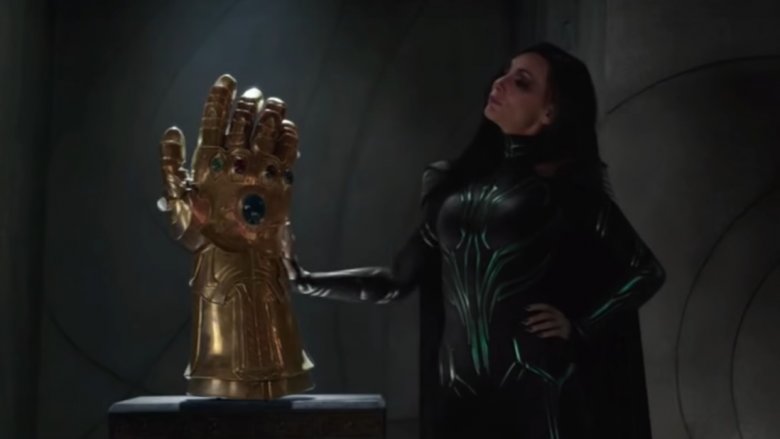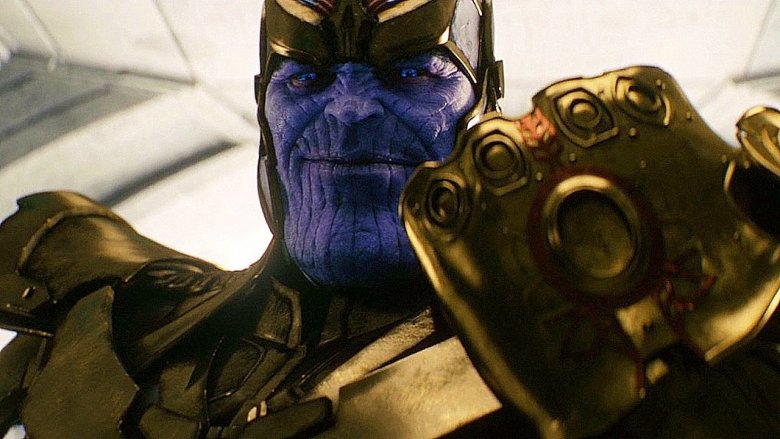How Thanos Really Got All The Infinity Stones
Ever since The Avengers, the Marvel Cinematic Universe had been building toward a showdown between the Avengers and Thanos. And when it finally came time for Earth's mightiest heroes to battle the Mad Titan, Marvel broke our hearts when Thanos pulled on that Infinity Gauntlet, snapped his fingers, and turned half of all living things into dust. Some fans have called this event "the Snappening." Marvel calls it "the Decimation." But whatever it's called, it couldn't have happened without the Infinity Stones.
These six glowing gems have played a key part in the MCU—appearing in movies from Thor to Captain Marvel. And once Thanos completed his rock collection, the stones gave him the power of a god. But now that we're nearing Endgame, it's time to press pause and figure out how the Mad Titan acquired those shiny stones. So if you're one of the lucky few who survived the Decimation, then don your supersuit and get ready for Endgame as we explore how Thanos got all six Infinity Stones.
The origins of the Infinity Stones
Pretty much everyone in the MCU—from Peter Quill to Cull Obsidian—has tried to get their hands on an Infinity Stone at one time or another. But with everybody searching for these magical rocks, we should probably ask, where did the Infinity Stones come from?
Well, Marvel revealed the Stones' backstory in Guardians of the Galaxy, when the ragtag sci-fi heroes visit an eccentric antiquer named Taneleer Tivan, aka the Collector (Benicio del Toro). As the Collector explains to Star-Lord and his crew, before the creation of the universe, there were six singularities. Then, after the Big Bang exploded everything into existence, "the remnants of these systems were formed into concentrated ingots: Infinity Stones."
As a result, these gems are incredibly powerful, with each one controlling an element of the universe: power, space, reality, souls, time, and minds. And unless you're some sort of celestial being, you can't touch these stones with your bare hand (not for very long anyway). That's why Infinity Stones tend to show up inside orbs, scepters, glowing blue cubes ... or a shiny gold glove.
The origin of the Infinity Gauntlet
Thanos is one of the few beings we've seen who's actually touched an Infinity Stone with his bare hands. But even the Mad Titan isn't strong enough to wield all six gems on his own. So in order to carry out his plans of mass murder, Thanos needed a hand—a giant golden hand. Known as the Infinity Gauntlet, this glove allows Thanos to harness the power of all the stones. Plus, it's incredibly stylish. But where did this ferocious yet fashionable weapon come from?
Well, in Avengers: Infinity War, Thanos pays a visit to Nidavellir, a realm populated by oversized dwarves. These otherworldly beings use the heart of a dying neutron star to forge powerful weapons, like Thor's hammer Mjolnir. Sadly, when Thanos arrived, he forced the dwarves to make him the gauntlet, and once he got the glove, he murdered everyone in Nidavellir except for King Eitri (Peter Dinklage). Of course, it's not like Eitri got away unscathed, as Thanos took the dwarf's hands in hopes he'd never forge a weapon as powerful as the gauntlet. And from there, Thanos set out to round up the stones, all while looking incredibly sharp.
The Power Stone (aka the Orb) isn't messing around
When Thanos first arrives in Avengers: Infinity War, the Mad Titan already has the Power Stone ready to go. So what's the story behind this purple gem? Well, the Power Stone does exactly what its name promises: It gives the user incredible power. In fact, long ago, the Power Stone was used by a Celestial named Eson the Searcher to wipe out entire civilizations. And while other ambitious beings tried to harness its energy, they were disintegrated quickly after coming into contact with the stone. In other words, you don't want to mess with this stone.
Eventually, the Power Stone was placed inside a metal Orb and hidden away on the desolate planet of Morag. When Thanos learned about its location, he sent one of his lackies, Ronan the Accuser, to retrieve it. But Ronan wasn't the only one looking for the Orb. After battling the angry blue alien, the Guardians of the Galaxy handed the stone over to the Nova Corps, an intergalactic police force on the planet Xandar, for safe-keeping. But when there's a genocidal warlord running around, nothing is safe for long.
In Infinity War, we learn that Thanos and his army have devastated Xandar, and after murdering everyone in his path, Thanos retrieved the Power Stone, making it the first gem added to his gauntlet. So when he finally shows up with that purple gem, he's ready to kill gods and smash Hulks.
The Space Stone (aka the Tesseract) takes a dive
Technically the first Infinity Stone to appear in the MCU, the Space Stone can manipulate space and let users teleport across the universe. But how did this shiny blue gem fall into Thanos' clutches? Well, first off, it's important to know the Space Stone was originally housed inside a cube known as the Tesseract. And long before the Marvel movies take place, the Tesseract belonged to Odin. For some reason, the Norse god thought it was a good idea to bring this insanely dangerous rock down to Earth, and his human worshipers hid the stone inside a Norwegian church, hoping it would never fall into evil hands.
Unfortunately, that's exactly what happens in Captain America: The First Avenger. During World War II, the Red Skull rolls into town and captures the Tesseract, hoping to create powerful weapons using the Cube's energy. Fortunately for humanity, Steve Rogers shows up to save the day. In the film's final battle—one that takes place in a Hydra warplane—Red Skull foolishly touches the Tesseract, which opens up a portal and sends him hurtling into space. The cube then burns a hole through the plane, Alien style, and falls into the Arctic Ocean below. Of course, the Space Stone wouldn't stay submerged for very long.
The Space Stone is put to marvel-ous use
After the climactic events of Captain America: The First Avenger, the Tesseract was discovered beneath the ocean waves by millionaire inventor Howard Stark. From there, the cube made its way to S.H.I.E.L.D., where in the 1990s, an undercover Kree scientist named Mar-Vell used the Space Stone to create a light-speed engine. She hoped the engine could help a persecuted alien race known as the Skrulls escape their tormentors (her own people) and find a new home, but her plan didn't exactly pan out.
Wanting to keep the Tesseract safe, Mar-Vell stored the cube aboard an invisible space station. This was a smart move as a band of genocidal Kree warriors eventually show up and murder poor Mar-Vell. But not all hope was lost that day. After a massive explosion, Mar-Vell's light speed engine imbued Air Force pilot Carol Danvers with superhuman abilities, and in Captain Marvel, she defeats the Kree, saves the Skrulls, and finds the Tesseract aboard Mar-Vell's space station.
From there, the Tesseract took a very strange direction, as it was gobbled up by a cat-like alien named Goose in an attempt to keep it safe from the Kree. And in the Captain Marvel post-credits scene, Goose vomits up the Tesseract on the desk of S.H.I.E.L.D. agent Nick Fury. Of course, S.H.I.E.L.D. isn't the most upstanding agency in the world, and they plan on using the Tesseract to create unstoppable weapons, but before they can get too far along with their project, a certain trickster god shows up with some very mischievous plans for the Space Stone.
The Space Stone and the god of mischief
In the post-credits scene of Thor, Nick Fury and Dr. Erik Selvig are seen admiring the Tesseract and talking about its "unlimited power." Unfortunately, they're not the only ones in the room. The duo doesn't know they're in the room with Loki, the god of mischief, and he's got his eye on the glowing blue cube.
See, Loki desperately wants to rule a planet. It doesn't matter if it's Earth or Asgard, so long as he's a king. So the trickster cuts a deal with Thanos. He'll retrieve the Space Stone from S.H.I.E.L.D. and give it to the Mad Titan if Thanos loans him a Chitauri army so he can invade Earth. Perhaps too dismissive of humanity, Thanos goes one step further and gives Loki an additional Infinity Stone, the Mind Stone, to help subjugate Earth.
Needless to say, Loki discovers he's a very puny god when he goes face-to-face with the Avengers. As a result, he's cuffed and carted off to an Asgardian prison. But he isn't the only thing returned to Odin's realm. Thor also takes the Space Stone back to Asgard where it's stored away in Odin's treasure room. But things take a sad turn in Thor: Ragnarok when Loki gets a bad case of light fingers.
Sure, by Ragnarok, Loki is one of the good guys, but he's still the god of mischief. And when he spots the Tesseract just sitting there, he has to steal it for himself. This proves to be a fateful decision for Loki. As he and the rest of Asgard abandons their destroyed homeland, they're attacked by Thanos' warship. Soon, the Mad Titan comes aboard, searching for the stone, and after Thanos brutally tortures Thor, Loki is forced to hand over the Tesseract. Now, Thanos has the power to teleport across the cosmos, and it's such a powerful scene that even Loki gets a little choked up.
The Reality Stone (aka the Aether) is really terrifying
One of the scariest stones in Thanos' gauntlet, the Reality Stone is a ruby-red gem that can alter the fabric of the universe itself. If you want to turn a wasted planet into a green paradise, you can. If you want to turn Drax the Destroyer into building blocks, you can do that, too. And bad guys have been trying to use the red stone for evil purposes since ancient times.
In Thor: The Dark World, we learn the Dark Elves wanted to plunge the universe into eternal night. And to do that, they needed the Reality Stone—particularly, a liquified version of the stone called the aether. Fortunately, way back in the day, King Bor (Odin's dad) defeated the elves. And when the creatures came back for round two, Thor hammers things out and captures the Reality Stone, canceling their dark plans.
However, the Asgardians were worried about housing the Reality Stone next to the Space Stone, so they handed it over to the Collector for safekeeping on Knowhere. Sure, the Collector was a shady dude who wanted the stones for his own purposes, but his dastardly plans were crushed when Thanos showed up and burned Knowhere to the ground. Now, with the Reality Stone in his possession, Thanos can shape the world exactly as he sees fit.
The Soul Stone is mysterious and magnificent
The most mysterious of the Infinity Stones, the Soul Stone has only appeared in one Marvel movie so far: Avengers: Infinity War. Eager to find its secret location, Thanos sent his daughter Gamora to find the orange gem, and while she did find it, she kept that from her dad, fearing what he might do if he found the Soul Stone.
But after a little bit of old-fashioned torture, Thanos learns the Soul Stone is hidden on the misty planet of Vormir. With his adopted daughter forcibly in tow, Thanos arrives on Vormir to discover a ghosty Red Skull guarding the gem. The red wraith explains there's only one way to get the Soul Stone: to sacrifice what you love the most. And for Thanos, that means tossing Gamora off the side of a cliff. After trading her life for the stone, he's one rock closer to completing his collection.
So what does the Soul Stone do? Well, obviously, it manipulates souls, or as the Russo brothers put it, "the essence of who you are." In the comics, it can trap spirits in a weird dimension called the Soul World, and it's possible that everyone Thanos killed in the Decimation is locked in this little universe. We also saw the Soul Stone in action when Thanos was battling Dr. Strange on Titan. When the sorcerer split up into like a hundred Stranges, Thanos used the Stone to reveal the true magician. And according to the Russo brothers, Thanos used the Soul Stone to "speak to his dead daughter," meaning he's got an "ability to resurrect, conjure the spiritual representation of people who are dead." So while its powers are still a bit ambiguous, the Soul Stone is so freaky because it gives Thanos power over death itself.
The Time Stone (aka the Eye of Agamotto) is very strange
Things get trippy when the Time Stone is around. This green gem gives users the power to manipulate the past, present, and future. Basically, it's a time machine inside a necklace, and the guy who first locked the stone inside that incredibly chic piece of jewelry was Agamotto, father of the mystic arts. Known henceforth as the Eye of Agamotto, this magical relic was placed inside the temple of Kamar-Taj and guarded by the Sorcerer Supreme, aka the Ancient One.
In Doctor Strange, surgeon-turned-sorcerer Stephen Strange learns how to manipulate time with the Eye and uses it to defeat the interdimensional demon Dormammu. Strange then becomes the protector of the stone, so when Thanos' children show up to run an errand for daddy, it's Strange's time to shine. Eventually, the good doctor and several other heroes arrive on the desolate world of Titan where they battle Thanos for control of the stone, and that's when things take a very strange turn.
Using the Time Stone, Strange looks into the future and perceives all possible outcomes for their battle with Thanos ... and there's only one in 14 million outcomes where the Avengers win. Believe it or not, that scenario requires Strange to hand over the green gem to Thanos, so when the Mad Titan is about to murder Tony Stark, Strange forks it over before turning into dust. Here's hoping Strange's suicidal plan makes a little more sense when Endgame rolls around.
The Mind Stone shows up on Earth
Thanos' biggest problem—besides the sadism and the genocide—is that he's too trusting. Before he decided to round up the Infinity Stones for himself, he asked his lackies to go out and collect his precious gems, and it backfired on him more than once. Take Loki, for example. When the god of mischief attacks New York City, he shows up with a fancy scepter that lets him control minds. And the spear's zombifying abilities come from the Mind Stone lodged inside its blade.
So yeah, the Mind Stone controls minds, and while it gave a blue glow inside Loki's scepter, it's really a bright yellow stone. And for some reason, Thanos foolishly gave it to Loki, hoping he could use it to retrieve the Space Stone from S.H.I.E.L.D. Of course, the Avengers ruined those plans, and S.H.I.E.L.D. confiscated the scepter, hoping to unlock its mind-controlling mysteries.
Unfortunately, S.H.I.E.L.D. was corrupt to its core. As we find out in Captain America: The Winter Soldier, the spy agency had been infiltrated by Hydra agents, and they use the spear to create superpowered beings to fight the Avengers, namely Quicksilver and Scarlet Witch. Their incredible abilities come courtesy of the gem; however, they're not the only Avengers beholden to the Mind Stone.
The Mind Stone is all about the Vision
In Age of Ultron, the titular robot was brought to life by the Mind Stone, and unfortunately for humanity, Ultron is a big fan of extinction events. He's also really into building himself stronger bodies to house his artificial consciousness, and his ultimate creation is this super sleek body made of vibranium. Of course, his piece de resistance comes when Ultron steals the Mind Stone and slaps it on top of his new body's forehead, hoping to give his future self powers beyond belief.
Fortunately, the Avengers ruin Ultron's makeover, and with the help of Thor's lightning, they bring his new creation to life. Known as the Vision, this Avenger is a nearly omnipotent being inextricably linked to the Mind Stone, so when Thanos shows up in Infinity War, Vision offers to sacrifice himself. If he destroys the stone, he'll die, but it will also ruin Thanos' genocidal plans.
While the Avengers shoot down his idea, eventually Scarlet Witch is forced to pull the trigger. Since her powers come courtesy of the Mind Stone, only she can destroy the gem lodged in Vision's forehead. But despite their noble effort, the Mad Titan has the Time Stone by this point and simply rewinds time and yanks the Mind Stone from Vision's skull, leaving the android crumpled on the ground. In a strange twist of fate, the Mind Stone was the first gem Thanos lost and the last one he acquired, allowing him to decimate the universe with a single snap.
Where are the stones now?
So what happened to the Infinity Stones after the Decimation? Well, that fateful snap definitely left Thanos and his glove looking a little worse for wear. On the Avengers: Infinity War commentary, director Joe Russo explained the Decimation "clearly damaged the gauntlet and damaged Thanos permanently." Still, despite the glove being badly burned, the stones all seem to be intact, and Thanos uses the Space Stone to portal out of Wakanda. So evidently, the gems are still working, and they will most definitely play a part in the upcoming battle. In the promotional materials for Endgame—like the teaser trailer and a cover of Empire magazine—it's clear that Thanos is still wearing that gauntlet while off playing farmer. And even though the Mad Titan's arm has been burned to a crisp, there's no doubt the stones will make things infinitely more difficult for the Avengers when they face off with the genocidal warlord for the final time.
Don't be fooled by the Casket of Ancient Winters
Keeping track of the Infinity Stones can be confusing, especially since there are so many glowing blue objects in the MCU. When the Mind Stone (which is yellow) appears in Loki's scepter, it gives off a blue hue. The Tesseract, obviously, is a glowing blue cube. On top of that, there's the Casket of Ancient Winters, yet another blue cube that appears in 2011's Thor ... the same movie that introduced the Space Stone.
But don't be confused, Marvel fans. The Casket of Ancient Winters has nothing to do with the Tesseract or the Infinity Gauntlet. To make this easy, just divide Thor in two: the movie proper and the post-credits scene. The glowing blue cube after the credits is the Space Stone. The glowing blue cube in the actual film is the Casket of Ancient Winters. But what is this so-called Casket?
Well, this blue box comes from the snowy planet of Jotunheim. It can turn people into ice, so it was a powerful weapon in the hands of the Frost Giants. But in the opening of Thor, the Casket gets locked away in Odin's treasure room. Of course, when Loki gets his hands on it, he starts freezing everyone in his way. Fortunately, the god of thunder puts Loki's plans on ice and returns the Casket to Odin's vault.
However, the Casket makes one final appearance in Thor: Ragnarok (where it's sitting just feet away from the Tesseract) before getting fried in the Asgardian apocalypse. So even though it's a glowing blue cube, the Casket has nothing to do with the Space Stone. Still, it's a pretty cool cube.
Don't be fooled by the fake Infinity Gauntlet
Back in 2011, Marvel was still figuring out where to take their franchise. They hadn't settled on the Infinity War storyline, and they didn't even know Thanos would be a major player until Joss Whedon decided to toss him into The Avengers. So when it came to release Thor, the folks at Marvel weren't thinking about the long-term ramifications of one little Easter egg.
During Thor's aborted coronation, some Frost Giants attempt to steal the Casket of Ancient Winters from Odin's treasure room. And during this scene, eagle-eyed fans will notice an Infinity Gauntlet—complete with all six stones—on display in Odin's vault. Obviously, it's just meant to be a fun Easter egg, but once the franchise started down the Infinity War path, Marvel had to figure out what to do with their little gag-gone-awry.
Fans have tried coming up with theories to explain why Odin would have his own gauntlet. Even MCU producer Kevin Feige proposed a possible solution. Speaking with Slashfilm, Feige said, "If the Asgardians knew that there was something ... that could theoretically wipe out Asgard and whatever else with ... a literal snap of the fingers, they might question Odin's ability to protect them. So Odin put a fake and he goes, 'It's fine, I got it. Look, it's fine, it's in our vault, don't worry about it.'"
Despite all the retcons, this is simply an Easter egg that didn't work out. But Thor: Ragnarok fixes this error in the best—and most hilarious—way possible, when Hela the goddess of death storms into Odin's treasure room, takes one look at the gauntlet, and dismisses the glove as "fake."
But what about that Age of Ultron scene?
When it comes to the Infinity Gauntlet, the post-credits scene from Avengers: Age of Ultron is more than a tad confusing. After the credits are done rolling, an angry Thanos storms onto the screen and declares he's going to find the Infinity Stones himself. However, he already has his Infinity Gauntlet, which doesn't jibe with the Marvel timeline.
Age of Ultron was released in 2015, and we see that Thanos has his glove ready to go. But when Infinity War came out three years later, it seems like the Mad Titan had just recently forced Eitri to forge the gauntlet. So what's going on here? Well, the writers of Infinity War have no clue. Speaking with Slashfilm, Christopher Markus and Stephen McFeely admit the Ultron scene has them baffled. The Russo brothers, however, have tried to retcon the situation.
Speaking with ComicBook.com, the directors explained the Infinity Gauntlet we see in Age of Ultron is the same one from Infinity War. "I think that it would be connected to Eitri," Joe Russo said. "I think that clearly he is the one who forged the gauntlet and Thanos had the gauntlet at that point in time. It's been a while since any of the Asgardians have interacted with Eitri and his people."
In other words, Thanos attacks the dwarves, gets his glove, and then angrily declares he'll collect the stones himself before kickstarting Infinity War. Sure, we're jumping through some hoops here, and it might not work out perfectly. But in a franchise that's beautifully spanned over 20 films, we're fine with explaining away a continuity error or two.
